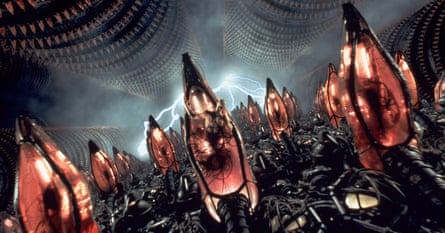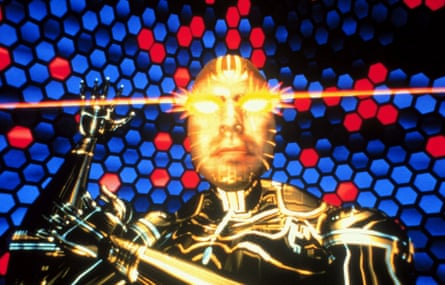It’s 2045 and Earth has been brought to its knees by catastrophic climate change and a worldwide energy crisis, not to mention famine, poverty, disease and war. In short, everything we presently fear has come to pass. It is the ultimate dystopian future.
That’s the premise of Ready Player One, a work of science fiction from 2011 by Ernest Cline and now a movie by Steven Spielberg. Wade Watts, the story’s protagonist, is born into a generation that feels failed by reality. The only thing making life bearable is the OASIS, a globally networked virtual reality world. Using a visor and a set of haptic-feedback gloves, Wade and millions like him enter its realm daily.
Designed by programming genius James Halliday, the OASIS started life as a video game, with people adopting avatars, going on quests and generally leaving the real world behind. Slaying your boss was a popular element of the game. “Ready Player One”, the message that greets players as they log on, is a reference to the coin-operated arcade machines of the 1980s, a decade that the book lionises with (and sometimes tedious) pop culture references.
But as Earth eventually collapsed, the OASIS became much more, functioning as a substitute for society. Wade attends school in the simulation, while his mother works two full-time jobs: one as a telemarketer, the other as an escort in an online brothel. Like millions of other users, Wade discovers a special purpose in the OASIS: the hunt for Halliday’s Easter Egg, a treasure hidden inside the simulation. Anyone hoping to find it must be a consummate geek and share Halliday’s passion for 80s pop culture. The finder will inherit not only the designer’s immense fortune but control of the virtual world.
Wade spends his nights revising – playing Galaga, a classic arcade game from the 80s, and reading X-Men comics – wedged between a wall and a dryer in his tiny trailer, every learned reference boosting his power in the simulation. He sees the OASIS and Halliday’s final quest as “an escape hatch into a better reality”.

Virtual reality isn’t often depicted so alluringly on film. The Matrix is one of the best-known VR dramatisations – and one of the bleakest. Following an unsuccessful war with intelligent machines, the human race is little more than a crop, a plentiful source of bioelectricity. For their entire “lives”, humans are hooked into a near-perfect simulation of the world as it was 200 years previously, blissfully unaware of their enslavement.
The Matrix presents VR as a form of sensory prison. In one of the most memorable scenes, we see what has become of the human race. From the cradle, we are locked away in small containment cells, kept alive by intrusive pipes, jacked into the matrix’s lulling code. Millions of humans, side by side, but walled off from each other. It’s the ultimate VR nightmare: the virtual has supplanted the real and isolated the individual. What’s more, we aren’t even aware of our incarceration.
The dilemma is best dramatised through Cypher, played by Joe Pantoliano. Although free from the matrix for nearly a decade, he cannot bear what has happened to the world. So he cuts a deal with the machines to re-enter the simulation and have all memories of the truth wiped. As he betrays his friends, and finalises the terms of his deal, he says: “You know, I know this steak doesn’t exist. I know that when I put it in my mouth, the Matrix is telling my brain that it is juicy and delicious. After nine years, you know what I realise?” He takes another bite. “Ignorance is bliss.”

Crucially, the film’s heroes – Neo, Morpheus, Trinity – resist the seductive simulation. Even though the real world is scorched and almost uninhabitable – far worse than the declining planet that Wade Watts seeks refuge from – it cannot be abandoned. The real must be valued above all else.
While The Matrix – hopefully – represents the worst-case scenario for the future of VR, it’s not alone in its negativity. Interestingly, VR is often treated with the same suspicion that has dogged video games as a whole over the last 30 years – that spending all day lost in a digital world is antisocial, morally suspect and corrupting.
The parallels are obvious in the somewhat dated 1992 film The Lawnmower Man. Based on a Stephen King short story, it stars Pierce Brosnan as the brilliant but quite mad scientist Dr Lawrence Angelo, who uses virtual worlds to expand the minds of chimpanzees. When his test chimp turns murderous – of course – he begins experimenting on Jobe, a man with learning difficulties who mows his lawn.

When his research stalls, Angelo retreats to his basement and spends hours in his VR worlds, neglecting his wife and various responsibilities. The room has the unmistakable funk of a teenager’s bedroom. In fact, his only real friend seems to be the kid next door, who believes that Angelo has all the best games and comes around to use the VR rig. While the visual effects look abysmal by today’s standards, Angelo’s psychedelic simulations pointedly resemble video games, including first-person shooters and racers. And their effect is literally mind-altering: Jobe becomes more intelligent, but they soon grant him the less desirable traits of telekinesis – and murderous rage. The moral isn’t hard to detect: spending your time hiding away and playing games is destructive and debasing. There is no wholesome substitute for the real world.
What such films fail to recognise is that, while VR attempts to fully immerse its user in an artificial world, it doesn’t have to isolate them. The recent Black Mirror episode San Junipero offered a more hopeful scenario. In the near future, the elderly escape to the simulated coastal party town of San Junipero, where they can relive their youth (it’s permanently 1987) and connect with others approaching the end of their natural lives.
Black Mirror generally offers up terrifying visions of a future distorted by technology, but here it explores its potential to unite people and create a new type of community. In this unusual love story, the main character Kelly eventually chooses to stay in the town after she dies, surviving beyond her body by allowing her consciousness to be digitised and uploaded to a server. There she’ll be for ever young, happy and with the one she loves. The simulation becomes a form of eternal life – an afterlife that exists not amid the clouds but in The Cloud, a sprawling data centre where the minds of the physically dead are kept “alive”.

At the beginning of Ready Player One, Wade reveals he has watched all 180 episodes of the 80s US sitcom Family Ties. “Sitting alone in the dark, watching the show on my laptop, I always imagined that I lived in that warm, well-lit house, and that those smiling, understanding people were my family.” While existing forms of entertainment – literature, TV, movies, games – do offer a form of escape, their effect is transient and fictional. Wade identifies strongly with the sitcom’s characters and their world, but seeks something more immersive and substantial.
Halliday originally designed the OASIS as a MMORPG (a “massively multiplayer online role-playing game”), that is to say, a virtual space intended to connect people, not separate them. Similar games already exist: World of Warcraft and EVE Online have supported large and sophisticated virtual communities for decades. They thrive on human interaction and would die without it.
This is the real reason why Wade is drawn into the OASIS and finds it so difficult to log off every night. He doesn’t escape into the unreal in search of selfish kicks or because the world is just too ugly. It’s because the inequality-riven, dystopian world of 2045 can no longer provide the social interaction and human connection he craves.

Comments (…)
Sign in or create your Guardian account to join the discussion